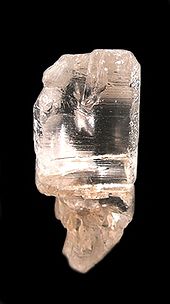| Revision as of 02:20, 16 April 2016 editVMS Mosaic (talk | contribs)Extended confirmed users, Pending changes reviewers, Rollbackers35,138 editsm minor fix← Previous edit | Revision as of 02:21, 16 April 2016 edit undoVMS Mosaic (talk | contribs)Extended confirmed users, Pending changes reviewers, Rollbackers35,138 editsm consistent spelling per WP:ENGVAR within articleNext edit → | ||
| Line 38: | Line 38: | ||
| }} | }} | ||
| '''Petalite''', also known as '''castorite''', is a ] ] ] ] ]]]<sub>4</sub>]<sub>10</sub>, crystallizing in the ] system. Petalite is a member of the ] group. It occurs as |
'''Petalite''', also known as '''castorite''', is a ] ] ] ] ]]]<sub>4</sub>]<sub>10</sub>, crystallizing in the ] system. Petalite is a member of the ] group. It occurs as colorless, grey, yellow, yellow grey, to white tabular crystals and columnar masses. Occurs in lithium-bearing ]s with ], ], and ]. Petalite is an important ore of lithium, and is converted to ] and ] by heating to ~500 °C and under 3 kbar of pressure in the presence of a dense hydrous alkali borosilicate fluid with a minor carbonate component.<ref>{{cite book|first=W. A. |last=Deer|title=Framework silicates: silica minerals, feldspathoids and the zeolites|year=2004|publisher=Geological Soc.|location=London|isbn=1-86239-144-0|pages=296|edition=2.}}</ref> The colorless varieties are often used as ]s. | ||
| ] | ] | ||
Revision as of 02:21, 16 April 2016
| Petalite | |
|---|---|
 Petalite from Minas Gerais State, Brazil (size: 3x4 cm) Petalite from Minas Gerais State, Brazil (size: 3x4 cm) | |
| General | |
| Category | Phyllosilicate |
| Formula (repeating unit) | LiAlSi4O10 |
| Strunz classification | 09.EF.05 |
| Crystal system | Monoclinic |
| Space group | Monoclinic prismatic H-M symbol: (2/m) Space group: P 2/a |
| Unit cell | a = 11.737 Å, b = 5.171 Å, c = 7.63 Å; β = 112.54°; Z = 2 |
| Identification | |
| Color | Colorless, grey, yellow, pink, to white |
| Crystal habit | Tabular prismatic crystals and columnar masses |
| Twinning | Common on {001}, lamellar |
| Cleavage | Perfect on {001}, poor on {201} with 38.5° angle between the two |
| Fracture | Subconchoidal |
| Tenacity | Brittle |
| Mohs scale hardness | 6 - 6.5 |
| Luster | Vitreous, pearly on cleavages |
| Streak | Colorless |
| Diaphaneity | Transparent to translucent |
| Specific gravity | 2.4 |
| Optical properties | Biaxial (+) |
| Refractive index | nα=1.504, nβ=1.510, nγ=1.516 |
| Birefringence | δ = 0.012 |
| 2V angle | 82 – 84° measured |
| Melting point | 1350 °C |
| Fusibility | 5 |
| Solubility | Insoluble |
| References | |
Petalite, also known as castorite, is a lithium aluminium phyllosilicate mineral LiAlSi4O10, crystallizing in the monoclinic system. Petalite is a member of the feldspathoid group. It occurs as colorless, grey, yellow, yellow grey, to white tabular crystals and columnar masses. Occurs in lithium-bearing pegmatites with spodumene, lepidolite, and tourmaline. Petalite is an important ore of lithium, and is converted to spodumene and quartz by heating to ~500 °C and under 3 kbar of pressure in the presence of a dense hydrous alkali borosilicate fluid with a minor carbonate component. The colorless varieties are often used as gemstones.

Discovery and occurrence

Discovered in 1800, by Brazilian naturalist Jose Bonifacio de Andrada e Silva. Type locality: Utö Island, Haninge, Stockholm, Sweden. The name is derived from the Greek word petalon, which means leaf.
Economic deposits of petalite are found near Kalgoorlie, Western Australia; Aracuai, Minas Gerais, Brazil; Karibib, Namibia; Manitoba, Canada; and Bikita, Zimbabwe.
The first important economic application for petalite was as a raw material for the glass-ceramic cooking ware CorningWare. It has been used as a raw material for ceramic glazes.
References
- "Petalite". Digital Fire. Retrieved 23 October 2011.
- Handbook of Mineralogy
- Webmineral
- ^ Mindat
- *Hurlbut, Cornelius S. and Klein, Cornelis, 1985, Manual of Mineralogy, Wiley, 20th ed., pp. 459-460 ISBN 0-471-80580-7
- Deer, W. A. (2004). Framework silicates: silica minerals, feldspathoids and the zeolites (2. ed.). London: Geological Soc. p. 296. ISBN 1-86239-144-0.
- D'Andraba (1800). "Des caractères et des propriétés de plusieurs nouveaux minérauxde Suède et de Norwège , avec quelques observations chimiques faites sur ces substances". Journal de chimie et de physique. 51: 239.
- Sowerby, James (1811). Exotic mineralogy: Or, Coloured figures of foreign minerals: As a supplement to British mineralogy.